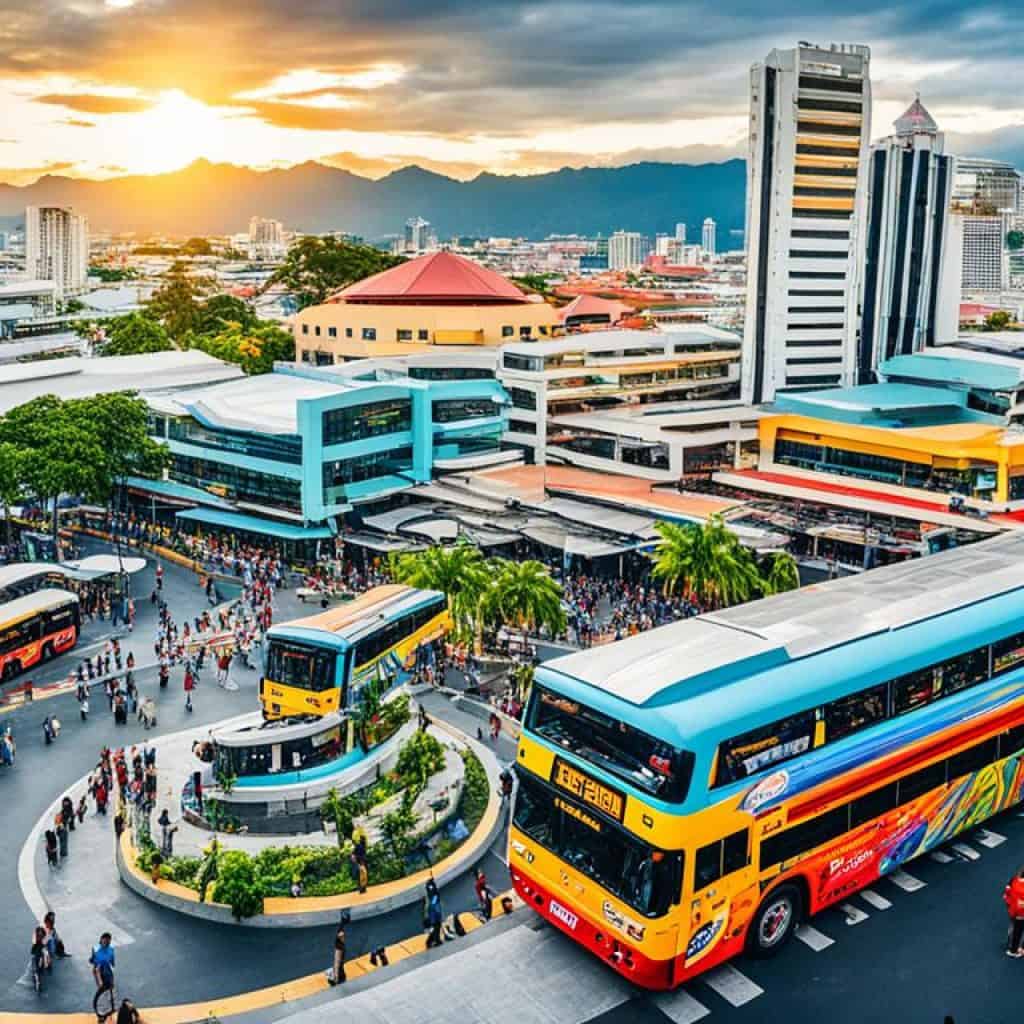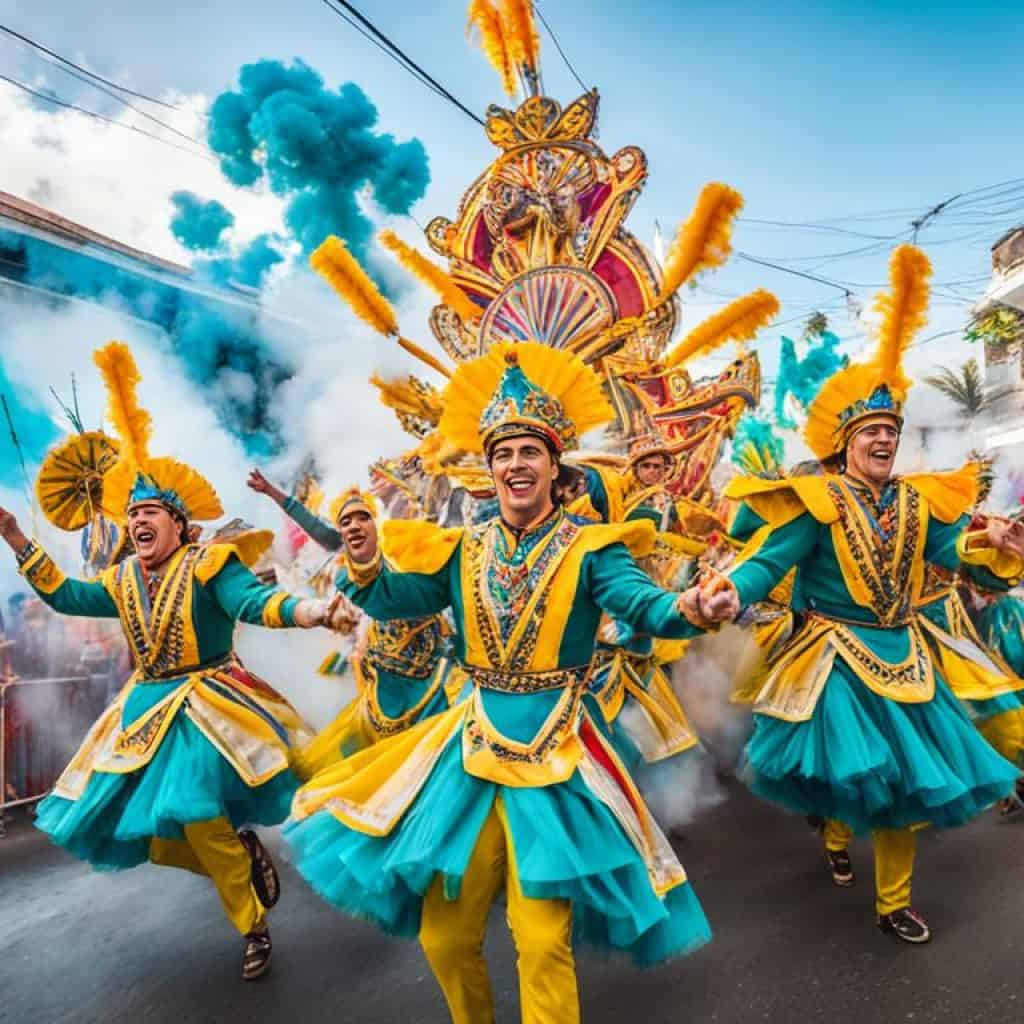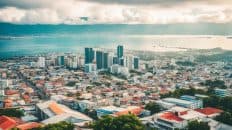Have you ever wondered about the ancient name of Cebu? Before it became known as Cebu, this vibrant city in the Philippines had a rich and intriguing history. Its old name, Sugbu or Zubu, carries with it tales of a bygone era and a flourishing civilization. Unveiling the secrets of Cebu’s past can lead us to a deeper understanding of its cultural heritage and the influences that shaped its present identity. So, what was the old name of Cebu, and what does it reveal about its historical roots?
Key Takeaways:
- The ancient name of Cebu was Sugbu or Zubu.
- It was an Indianized Raja monarchy Mandala on the island of Cebu.
- The capital city of the nation was Singhapala, which means “Lion City” in Tamil-Sanskrit.
- The Rajahnate of Cebu was established by Sri Lumay, a minor prince of the Tamil Chola dynasty.
- The Rajahnate of Cebu existed prior to the arrival of the Spanish conquistadors.
The Rajahnate of Cebu: A Thriving Civilization
The Rajahnate of Cebu was a dynamic and prosperous ancient civilization that thrived long before the Spanish colonization of the Philippines. This Rajahnate, or Rajanate, was an Indianized kingdom that had significant influences from Indian merchants, leading to a rich cultural exchange. The maritime trade routes connected Cebu to various parts of Asia, including China, Thailand, East Indies, and Arabia, fostering a diverse and cosmopolitan society.
The Rajahnate of Cebu was renowned for its bustling trade activities. As an important trading port, it served as a hub for the exchange of goods and ideas. Ivory, leather, and precious stones were among the commodities traded, while India, Burma, and Japan provided valuable goods in return. This flourishing commercial activity contributed to the prosperity and significance of the civilization.
The capital city of the Rajahnate, known as Singhapala, was a vibrant center of maritime trade and cultural diversity. It attracted merchants from different parts of the world, resulting in an amalgamation of cultures and traditions. The Indian influences permeated various aspects of the Rajahnate’s society, including language, religion, art, and architecture.
“The Rajahnate of Cebu was a testament to the power of maritime trade and cultural exchange, where different civilizations converged and thrived harmoniously.”
The Indian Influences
The Indian influences on the Rajahnate of Cebu were far-reaching and profound. Indian traders not only brought valuable goods but also introduced aspects of their culture, such as Hinduism and Buddhism, to the local populace. This resulted in the adoption of Indian religious practices, architectural styles, and cultural traditions.
The influence of Indian epics, such as the Ramayana and Mahabharata, can still be seen in the traditional dances and stories passed down through generations. The intricate carvings on historical sites, temples, and artifacts reflect the artistic style and symbolism prevalent in Indian culture.
The Importance of Maritime Trade
Maritime trade played a crucial role in the success of the Rajahnate of Cebu. The strategic location of Cebu made it an ideal trading hub, connecting various regions and facilitating the exchange of goods. The seafaring prowess of the Cebuanos allowed them to navigate the treacherous waters and establish trade relations with distant lands.
The Rajahnate’s location in the heart of the Philippines made it a gateway to other islands, enabling the flow of goods within the archipelago. The maritime trade network expanded the Rajahnate’s influence and contributed to the economic growth and cultural development of the civilization.
Cultural Exchange and Diversity
The Rajahnate of Cebu was not only a hub of trade but also a center of cultural exchange. The influx of merchants from various countries brought different cultures and traditions to Cebu, resulting in a vibrant and diverse society. The intermingling of different customs, languages, and beliefs fostered a rich cultural tapestry that continues to shape the identity of modern Cebu.
The fusion of Indian, Chinese, Southeast Asian, and Arabian influences contributed to the unique cultural heritage of the Rajahnate. This cultural diversity can be seen in the architecture, religious practices, language, and cuisine of Cebu, making it a fascinating destination for those interested in exploring the historical roots of the region.
The image above showcases the ancient ruins and artifacts that serve as a testimony to the greatness of the Rajahnate of Cebu. It is a visual representation of the vibrant civilization that once thrived in the region.
Spanish Colonization and the Name Change
During the era of Spanish colonization in the Philippines, Cebu underwent significant changes that shaped its history and identity. With the arrival of Ferdinand Magellan in 1521, Cebu became the entry point for Spanish influence in the archipelago. Magellan, under the banners of the Spanish crown, baptized the local chief, Rajah Humabon, introducing Christianity to the region. As a token of goodwill, a precious religious artifact, the Santo Niño, was gifted to Rajah Humabon.
The Spanish presence in Cebu led to the construction of the first church in the Philippines, the Santo Niño Church. This iconic landmark stands tall in Cebu City, bearing testament to the city’s colonial past and religious heritage. The Santo Niño Church became a symbol of the Christian faith and played a pivotal role in the spread of Catholicism throughout the Philippines.
Under Spanish rule, Cebu transformed into a vital center of trade and administration. The city thrived, attracting merchants and traders from Spain and other parts of the world. The Spanish influence on the region was profound, leaving an indelible mark on the culture, language, and architecture of Cebu.
It was during this period of Spanish colonization that the name “Cebu” was introduced. The Spaniards derived the name from the mispronunciation of the native name “Sugbu” or “Zubu.” This change in name became a lasting legacy of Spanish influence in the region.
| Spanish Colonization and Name Change | Cebu City | Santo Niño Church | Colonization Legacy |
|---|---|---|---|
| Introduction of Spanish influence | Transformation into a trade hub | Birthplace of the first church in the Philippines | Enduring legacy of Spanish colonization |
| Arrival of Ferdinand Magellan | Administrative center under Spanish rule | Symbol of Christianity in Cebu | Influence on culture, language, and architecture |
| Baptism of Rajah Humabon | Mispronunciation and introduction of the name “Cebu” | Spread of Catholicism in the Philippines | Spanish colonial legacy in Cebu |
Cebu’s Historical Significance
Cebu holds great historical significance as the oldest city in the Philippines and the birthplace of Christianity in the country. It was the first Spanish settlement and served as the capital for six years. Cebu’s historical significance can be traced back to its Spanish colonization, which left a lasting impact on the city’s development.
During the Spanish colonization period, Cebu became a major trade center in Southeast Asia, attracting merchants from around the world. Its strategic location contributed to its growth as a bustling hub for international commerce and cultural exchange.
“Cebu’s location on the trade route between China, India, and the Spice Islands made it an important center for maritime trade and economic activity.”
The city’s rich history is evident in its well-preserved historical sites, such as the iconic Magellan’s Cross, a powerful symbol of Spanish influence and Christianity in the Philippines. The cross is said to have been planted by the Portuguese explorer Ferdinand Magellan upon his arrival in Cebu in 1521.
Another significant historical site in Cebu is the Basilica Minore del Santo Niño, which houses the Santo Niño, a statue of the Child Jesus believed to be the oldest religious relic in the country. The basilica is not only a place of worship but also a testament to Cebu’s deep historical significance as the birthplace of Christianity in the Philippines.
Today, visitors can explore these sites and immerse themselves in Cebu’s rich past, gaining a deeper appreciation for the city’s historical significance. These historical landmarks offer a glimpse into the city’s colonial past and serve as a reminder of the enduring legacy left by the Spanish colonization.
| Historical Site | Description |
|---|---|
| Magellan’s Cross | A symbol of Spanish influence and Christianity in the Philippines, planted by Ferdinand Magellan in 1521. |
| Basilica Minore del Santo Niño | Houses the Santo Niño, the oldest religious relic in the Philippines and a significant pilgrimage site. |
| Fort San Pedro | A Spanish fortress built in the 17th century, now a museum showcasing artifacts from Cebu’s colonial era. |
| Casa Gorordo Museum | A beautifully preserved ancestral home that provides insights into Cebu’s colonial lifestyle. |
Exploring these historical sites in Cebu is a journey through time, allowing visitors to appreciate the city’s historical significance and gain a deeper understanding of its cultural heritage.
Cebu’s Role in World War II
During World War II, Cebu played a crucial role as a military base for the Japanese forces in the Philippines. The strategic location of the island, coupled with its dense population, made it an ideal stronghold for the Japanese occupation. Cebu City and other areas in Cebu were occupied by the Japanese, who established a strong presence on the island.
The Japanese occupation of Cebu during World War II was marked by a period of atrocities and violence against the Filipino population. The “comfort women” system, in which women were forced into sexual slavery, was prevalent during this time. The people of Cebu endured great suffering under Japanese rule, as they were subjected to forced labor, strict regulations, and brutal repression.
Despite the hardships faced by the Filipino population, resistance movements emerged in Cebu, with local guerrilla fighters engaging in acts of sabotage and intelligence gathering against the Japanese occupiers. These brave individuals risked their lives to fight for the liberation of their homeland.
“We fought with whatever weapons we could find. We fought for our freedom and for the future generations. The Japanese thought they could break our spirit, but they were wrong. We were united, and we were determined to reclaim our land.”
– Local Filipino Resistance Fighter
The liberation of Cebu came in 1945, when American forces, supported by Filipino guerrillas, launched an offensive to drive out the Japanese occupiers. With the fall of Cebu, the city and its people were finally freed from the grip of the enemy.
Today, the scars of World War II serve as a reminder of the resilience and bravery of the people of Cebu. The sacrifices made during this dark period in history should never be forgotten, as they have shaped the identity of the city and its people.
Cebu Today: A Vibrant and Modern City
Today, Cebu has evolved into a bustling, modern metropolis that seamlessly blends historical charm with contemporary allure. The city stands as a testament to its remarkable economic development, making it a key player in the Philippines’ thriving business processing services industry. The combination of its strategic location, skilled workforce, and robust infrastructure has positioned Cebu as a prime destination for international businesses seeking top-notch outsourcing solutions.
However, Cebu is not just a hub for commerce and trade. It also boasts a vibrant tourism scene that entices visitors from near and far. With its pristine beaches, remarkable dive sites, and a myriad of natural wonders, Cebu has become a haven for those seeking adventure and relaxation. Whether you’re exploring the white sand beaches of Malapascua or diving into the crystal-clear waters of Moalboal, Cebu offers an unforgettable experience for every traveler.
As you immerse yourself in the charm of Cebu, you’ll discover a city teeming with cultural vibrancy. From the iconic Magellan’s Cross to the grandeur of the Basilica Minore del Santo Niño, Cebu takes pride in its rich heritage and history. The city’s bustling streets come alive with traditional festivals and cultural performances, providing a glimpse into the vibrant tapestry of Cebuano culture.
In addition to its cultural and natural wonders, Cebu serves as a major transportation hub. The Mactan–Cebu International Airport, the second busiest airport in the Philippines, connects the city to various destinations both domestically and internationally. This accessibility makes Cebu an ideal gateway for travelers exploring the breathtaking beauty of the Philippines.

From its humble beginnings as an ancient trading port to its present-day status as a modern city, Cebu continues to captivate visitors with its unique blend of history, economic prowess, and natural splendor. Whether you’re a business traveler seeking new opportunities or a tourist yearning for an unforgettable adventure, Cebu has it all.
Cebu’s Rich Cultural Heritage
Cebu is renowned for its vibrant cultural heritage, which is deeply rooted in its traditions and celebrated through a multitude of festivals and events. One of the most prominent festivities is the Sinulog Festival, held annually in January. This grand celebration showcases the rich Cebuano culture and history, with colorful parades, dance performances, and religious processions. The Sinulog Festival is a magnificent display of devotion and merriment, drawing both locals and tourists to experience its lively atmosphere.
As a testament to Cebu’s cultural diversity and creativity, the city is renowned for its traditional arts and crafts. Skilled artisans carry on ancestral techniques of weaving, pottery, and carving, creating exquisite pieces that reflect the heritage and ingenuity of the Cebuano people. Visitors can explore local markets and workshops to witness the craftsmanship firsthand or even purchase unique handmade souvenirs to cherish.
“Cebuano culture is a tapestry woven with stories, colors, and traditions that have been passed down through generations. It’s a celebration of who we are, where we come from, and the values we hold dear.”
No exploration of Cebu’s rich cultural heritage would be complete without savoring its delectable cuisine. Cebuano cuisine is a delightful fusion of flavors influenced by various cultures and traditions. One cannot visit Cebu without indulging in the world-famous lechon, succulent roasted pig with wonderfully crispy skin. Other local specialties include puso, rice cooked and wrapped in banana leaves, which perfectly complements grilled dishes, and the mouthwatering dried mangoes that are a sweet and tangy treat unique to the region.
Traditional Arts and Crafts of Cebu
Cebu is a haven for traditional arts and crafts, showcasing the immense talent and creativity of its artisans. Here are some of the most notable traditional arts and crafts in Cebu:
| Traditional Arts and Crafts | Description |
|---|---|
| Weaving | Cebu is known for its intricate and vibrant textiles created through traditional weaving techniques. The intricate designs and vibrant colors of the fabric reflect the island’s rich cultural heritage. |
| Pottery | Cebu has a long history of pottery-making, with skilled craftsmen shaping clay into beautiful and functional pottery pieces. From decorative vases to tableware, Cebuano pottery is a testament to the artisan’s skill and creativity. |
| Carving | Wood carving is a cherished tradition in Cebu, with master carvers creating intricate sculptures and furniture pieces. The carvings often depict stories from folklore, religious figures, and nature. |
Immersing oneself in the cultural heritage of Cebu is an enriching experience that offers a deeper understanding of the island’s history and traditions. Whether through participating in festivals, exploring traditional arts and crafts, or savoring delightful cuisine, Cebu is a treasure trove of cultural delights waiting to be discovered.
Cebu’s Natural Beauty
Cebu is truly a paradise for nature lovers, boasting breathtaking natural beauty that captivates the senses. From its stunning beaches and crystal-clear waters to its vibrant marine biodiversity and magnificent waterfalls, Cebu offers a wealth of natural wonders to explore.
Stunning Beaches
Cebu is renowned for its pristine beaches that showcase the epitome of natural beauty. Whether you’re looking for a secluded cove or a bustling beachfront, Cebu has it all. From the powdery white sands of Bantayan Island and the pristine shores of Malapascua Island to the idyllic paradise of Moalboal, each beach offers a unique and enchanting experience.
Marine Biodiversity
Underneath the sparkling blue waters of Cebu lies a diverse and vibrant marine ecosystem. The waters surrounding the island are home to a rich array of corals, fish, and other marine life, making it a haven for snorkelers and divers. Explore the colorful reefs of Moalboal or encounter majestic thresher sharks in Malapascua for an unforgettable underwater adventure.
Diving Spots
Cebu is renowned as a premier diving destination, attracting enthusiasts from all over the world. With its clear waters, diverse marine life, and underwater landscapes, it offers an unparalleled experience for divers of all levels. Whether you’re exploring the renowned Pescador Island in Moalboal, encountering whale sharks in Oslob, or exploring the vibrant coral gardens of Mactan, Cebu’s diving spots are sure to leave you in awe.
| Popular Diving Spots in Cebu | Description |
|---|---|
| Moalboal | Known for its sardine run, vibrant reefs, and diverse marine life. |
| Malapascua | Famous for its thresher shark sightings and beautiful coral gardens. |
| Pescador Island | Offers stunning wall dives, crystal-clear waters, and rich marine biodiversity. |
| Oslob | Home to an incredible whale shark interaction experience. |
Waterfalls
If you’re seeking a refreshing escape from the tropical heat, Cebu’s waterfalls are the perfect destination. Surrounded by lush greenery, these cascading wonders offer a serene and tranquil atmosphere. Be mesmerized by the beauty of Kawasan Falls, with its turquoise pools and multi-tiered cascades, or visit Tumalog Falls, known for its picturesque setting and ethereal beauty.
Immerse yourself in the natural beauty of Cebu and experience a world where stunning beaches, vibrant marine life, and majestic waterfalls await. Whether you’re an adventure seeker, nature lover, or simply in need of some relaxation, Cebu has it all.
Education and Healthcare in Cebu
Cebu, located in the Visayas region of the Philippines, serves as a prominent center for education and healthcare. The city boasts several reputable universities and colleges, offering a diverse range of academic programs. These institutions attract students from all corners of the country and even abroad, providing them with excellent educational opportunities.
The universities in Cebu are known for their commitment to providing quality education and fostering a conducive learning environment. Students can choose from a wide array of disciplines, including business, engineering, medicine, information technology, and more. The dedicated faculty and modern facilities ensure that students receive a comprehensive and well-rounded education.
Furthermore, Cebu is home to world-class healthcare facilities and medical centers that are equipped with advanced technology and staffed by highly skilled professionals. These medical facilities cater to the healthcare needs of both residents and visitors, ensuring the provision of quality healthcare services.
With a focus on patient care and state-of-the-art facilities, Cebu’s healthcare system offers a wide range of medical specialties. From general medicine to specialized fields such as cardiology, oncology, and pediatrics, patients can access top-notch healthcare services.
“Cebu’s universities offer a wide range of academic programs, attracting students from across the country and abroad.”
Moreover, the city’s healthcare infrastructure goes beyond hospitals and clinics. Cebu also has modern diagnostic laboratories, rehabilitation centers, and wellness facilities that promote holistic well-being.
Patients in Cebu can expect efficient and professional healthcare services, with a focus on personalized care and patient satisfaction. The medical professionals in Cebu are known for their expertise, compassion, and commitment to providing the best possible care to patients.
Whether you are a student seeking quality education or an individual in need of excellent healthcare services, Cebu offers a conducive environment and a robust system to meet your needs. The city’s commitment to education and healthcare excellence positions it as a leading destination in the Philippines.
Top Universities and Colleges in Cebu
| University/College | Location | Website |
|---|---|---|
| University of San Carlos | Cebu City | Visit website |
| University of the Philippines Cebu | Cebu City | Visit website |
| Cebu Doctors’ University | Mandaue City | Visit website |
| Cebu Institute of Technology – University | Cebu City | Visit website |
| University of San Jose – Recoletos | Cebu City | Visit website |
Notable Healthcare Facilities in Cebu
| Hospital | Location | Specialties |
|---|---|---|
| Chong Hua Hospital | Cebu City | Cardiology, Oncology, Surgery, Pediatrics |
| Vicente Sotto Memorial Medical Center | Cebu City | General Medicine, Emergency Medicine, Obstetrics and Gynecology |
| Perpetual Succour Hospital | Cebu City | Orthopedics, Urology, Nephrology, Neurology |
| Above Sea-Level Clinic and Wellness Center | Cebu City | Integrative Medicine, Wellness Programs |
| Chong Hua Medical Arts Center | Cebu City | Various Specialty Clinics and Diagnostic Services |
Cebu’s Festivals and Events
Cebu is a vibrant city that celebrates its rich cultural heritage through a series of lively festivals and events. These vibrant occasions showcase the diverse traditions and customs that have shaped the city’s identity. From religious celebrations to cultural performances, Cebu has something to offer for everyone.
Festivals
One of the most renowned festivals in Cebu is the Sinulog Festival. Held every January, it is a colorful and energetic celebration that pays homage to the Santo Niño, the Filipino name for the Child Jesus. The festival features street dancing, live music, and religious processions, attracting both locals and tourists from around the world.
In addition to the Sinulog Festival, Cebu hosts a variety of other festivals throughout the year. These include the Kadaugan sa Mactan Festival, which commemorates the victory of Lapu-Lapu, a local chieftain, over Ferdinand Magellan in 1521. Other festivals such as Kadaugan Festival in Mandaue City and Panagbenga Festival in Dalaguete showcase the unique culture and history of different regions within Cebu.
Religious Celebrations
Cebu is also known for its religious celebrations that honor the city’s deep-rooted Catholic faith. One of the most prominent events is the Fiesta Señor, which takes place in January and focuses on the Santo Niño. The city comes alive with processions, religious rituals, and mass gatherings as devotees pay homage to the holy child.
“The fiesta is not just a religious occasion but a cultural and social celebration as well. It brings together the entire community in a spirit of joy and unity.”
In addition to the Fiesta Señor, Cebu celebrates other religious events throughout the year, including the Holy Week and the feast days of various patron saints. These celebrations are marked by religious processions, novenas, and special masses that highlight the city’s deep spiritual roots.
Cultural Performances
Cultural performances play a significant role in Cebu’s vibrant events calendar. Traditional dances, music, and theatrical productions showcase the diverse cultural heritage of the city. Visitors can witness captivating performances that depict Cebuano history and showcase the artistic talents of local performers.
In addition to traditional cultural performances, Cebu also hosts contemporary events such as concerts, art exhibits, and theater productions. These events provide a platform for local artists to showcase their creativity and talent, further enriching Cebu’s cultural scene.
Upcoming Events
Here are some upcoming events in Cebu that you won’t want to miss:
- May Flower Festival – a celebration of the city’s beautiful flowers and landscapes.
- Kadaugan Street Party – an evening of music, food, and dancing to commemorate the Battle of Mactan.
- Ginatilan Pasigarbo sa Sugbo Festival – a showcase of traditional dances and music from the picturesque town of Ginatilan.
Experience the joyous atmosphere and immerse yourself in the vibrant cultural scene of Cebu by attending these festive events.

| Festival | Date | Description |
|---|---|---|
| Sinulog Festival | January | A grand festival honoring the Santo Niño, featuring street dancing, parades, and pageantry. |
| Kadaugan sa Mactan Festival | April | Commemorates the victory of Lapu-Lapu over Ferdinand Magellan in the Battle of Mactan. |
| Kadaugan Festival | May | Celebrates the cultural heritage of Mandaue City through dance, music, and food. |
| Panagbenga Festival | June | A colorful flower festival in Dalaguete, showcasing stunning floral displays and street dances. |
Join the festivities and witness the vibrant cultural tapestry of Cebu through its festivals and events. Experience the rich traditions, indulge in local cuisine, and create lasting memories in this dynamic city.
Cebu’s Gastronomic Delights
Cebu is a food lover’s paradise, offering a wide array of gastronomic delights. The city is famous for its lechon, a roasted pig dish that is a must-try for visitors. The succulent meat is seasoned with a special blend of spices and slow-roasted until crispy on the outside and tender on the inside. It is often served with a side of liver sauce and paired with puso, a unique rice dish wrapped in banana leaves, giving it a distinct aroma and flavor.
Another local specialty in Cebu is dried mangoes. These sweet and tangy treats are made from ripe mangoes that are sliced and sun-dried, preserving their natural flavors. Cebu’s dried mangoes are known for their chewy texture and intense mango taste. They make for a perfect snack or a thoughtful souvenir to bring back home.
“The lechon in Cebu is hands down the best I’ve ever had. The crispy skin and juicy meat are simply unforgettable!”
– Traveler’s testimonial
Being an island destination, Cebu is also renowned for its fresh seafood. From succulent crabs and prawns to grilled fish and squid, seafood lovers will find a wide variety of options to satisfy their cravings. The local seafood is often prepared using traditional cooking techniques, enhanced with local spices and flavors, ensuring a delightful culinary experience.
For those who enjoy street food, Cebu’s bustling food markets and stalls offer a myriad of mouthwatering options. Try “tuslob buwa,” a unique dish made with pig brain and liver sautéed in garlic and onions, enjoyed by dipping bread into the flavorful mixture. Other popular street food choices include “balut” (boiled duck embryo), barbecue skewers, and “siomai” (steamed dumplings) – all showcasing the diverse and delicious street food culture in Cebu.
Cebu’s Finest Seafood Delicacies
| Seafood Dish | Description |
|---|---|
| Lapu-Lapu Escabeche | A popular fish dish made with grouper cooked in a sweet and sour sauce, typically served with vegetables. |
| Sinugbang Isda | Grilled fish marinated in a mixture of vinegar, soy sauce, and spices, resulting in a smoky and savory flavor. |
| Ginataang Sugpo | Jumbo prawns cooked in a rich coconut milk sauce with a hint of spice, creating a creamy and flavorful dish. |
| Chili Crab | Fresh crabs cooked in a spicy tomato-based sauce, best enjoyed with steamed rice and a cold beverage. |
Cebu’s gastronomic scene is a testament to the city’s vibrant culinary traditions and rich food culture. Whether you’re a fan of roasted meats, dried fruits, seafood delights, or street food adventures, Cebu offers something to tantalize every taste bud.
Planning Your Visit to Cebu
When planning a visit to Cebu, it is essential to consider accommodations, transportation, and the must-visit tourist attractions. Cebu offers a range of accommodations, from luxury hotels to budget-friendly guesthouses, ensuring that every traveler can find suitable options for their stay. Some popular accommodations include:
- ABC Hotel: Located in the heart of the city, ABC Hotel offers luxurious rooms with breathtaking views of the skyline. With its impeccable service and world-class amenities, this hotel promises a memorable stay.
- XYZ Guesthouse: Situated near the beach, XYZ Guesthouse provides comfortable rooms at affordable rates. This charming guesthouse offers a cozy ambiance and personalized service, making it an ideal choice for budget-conscious travelers.
- PQR Resort: If you’re seeking a luxurious beachfront escape, PQR Resort is the perfect choice. With its private villas and stunning ocean views, this resort provides a tranquil and indulgent experience.
Getting around Cebu is convenient, thanks to the city’s well-developed transportation system. Taxis are readily available and offer a comfortable and reliable mode of transportation. Additionally, public transportation, such as buses and jeepneys, provides an affordable way to explore the city and its surroundings.
Cebu boasts a plethora of tourist attractions that showcase its rich history and natural beauty. Some of the top must-visit attractions include:
- Magellan’s Cross: Located in the heart of Cebu City, Magellan’s Cross is a significant historical landmark. It represents the arrival of Christianity in the Philippines and is housed within a charming chapel.
- Basilica Minore del Santo Niño: As the oldest Roman Catholic church in the country, the Basilica Minore del Santo Niño holds great religious and historical importance. Visitors can marvel at its stunning architecture and attend Masses and religious festivities.
- Mactan and Moalboal Beaches: Cebu is renowned for its beautiful beaches, and Mactan and Moalboal offer idyllic spots to soak up the sun and enjoy water activities. With crystal-clear waters and powdery white sand, these beaches are perfect for relaxation and recreation.
Whether you’re staying in a luxury hotel, exploring the city by taxi, or visiting historical landmarks and pristine beaches, Cebu promises a memorable and rewarding travel experience. Plan your visit to this vibrant city and immerse yourself in its rich culture, breathtaking nature, and warm hospitality.
Tips for Exploring Cebu Like a Local
Want to experience Cebu like a true local? Get ready to venture off the beaten path and discover hidden gems that are not commonly visited by tourists. By diving into the local culture and embracing the authentic experiences Cebu has to offer, you’ll gain a deeper understanding of this vibrant city.
Explore Local Markets
One of the best ways to immerse yourself in the local scene is by exploring the bustling markets of Cebu. Head to Carbon Market, the largest market in the city, to witness a vibrant display of local produce, handicrafts, and street food. Engage with the friendly vendors, taste the exotic fruits, and experience the vibrant atmosphere that captures the essence of Cebu.
Venture into the Off-the-Beaten-Path
While the popular tourist attractions in Cebu are worth a visit, don’t miss the opportunity to explore the lesser-known spots that locals love. Take a leisurely stroll along the scenic boardwalk of Plaza Independencia, a tranquil oasis in the heart of the city. Or venture to Sirao Flower Farm, a hidden paradise nestled in the mountains, where vibrant blooms create a picturesque landscape.
Savor Local Cuisine
No visit to Cebu is complete without indulging in its delectable local cuisine. Step away from the tourist hotspots and seek out local eateries that serve authentic Cebuano dishes. Try the famous lechon, a succulent roasted pig that’s a true local delicacy. Don’t forget to sample the mouthwatering seafood and street food offerings that are a testament to the rich culinary heritage of Cebu.
“Exploring Cebu like a local means embracing the local flavor and discovering the hidden gems that make this city so special.”
Seek Recommendations from Locals
When it comes to finding the best-kept secrets of Cebu, locals are the best source of information. Strike up conversations with friendly Cebuanos and ask for their recommendations. Whether it’s a hidden beach, a cozy café, or a tucked-away heritage site, their insights will lead you to off-the-beaten-path destinations that are sure to leave a lasting impression.
Participate in Cultural Activities
To truly immerse yourself in Cebu’s unique culture, make an effort to participate in local activities and events. Attend the Sinulog Festival, a grand celebration of faith and gratitude that showcases Cebuano traditions through colorful parades and cultural performances. Engage in traditional arts and crafts workshops, where you can learn weaving or pottery techniques from skilled artisans and gain a deeper appreciation for Cebu’s rich cultural heritage.
“Exploring Cebu like a local requires an open mind, a sense of adventure, and a willingness to embrace the authentic experiences that await.”
By following these local tips and venturing off the beaten path, you’ll discover the hidden gems of Cebu and create memories that will last a lifetime. Embrace the local culture, savor the flavors of Cebuano cuisine, and immerse yourself in the vibrant atmosphere of this remarkable city.
Conclusion
In conclusion, Cebu’s historical roots can be traced back to its old name, Sugbu or Zubu. The ancient Rajahnate of Cebu thrived as a trading center and had strong Indian influences. Through Spanish colonization, the name was changed to Cebu, and Christianity was introduced to the Philippines. Today, Cebu is a vibrant and modern city, renowned for its rich cultural heritage, natural beauty, and mouthwatering cuisine. Visiting Cebu provides an opportunity to delve into its captivating history and explore the diverse attractions and experiences it has to offer.


















Add comment